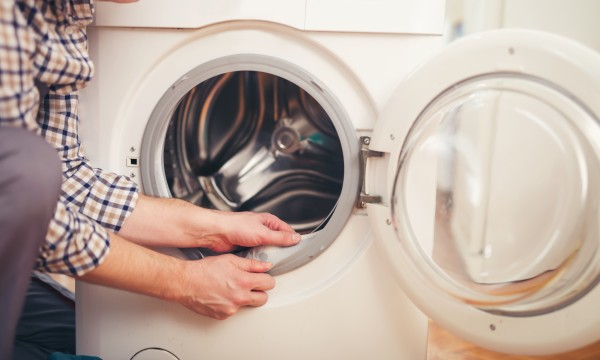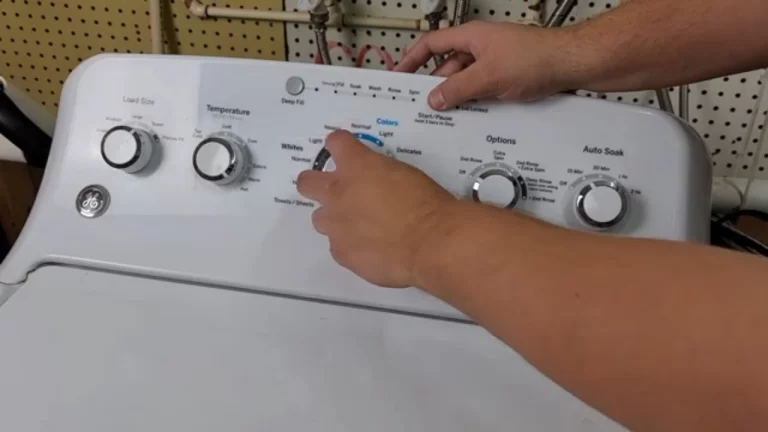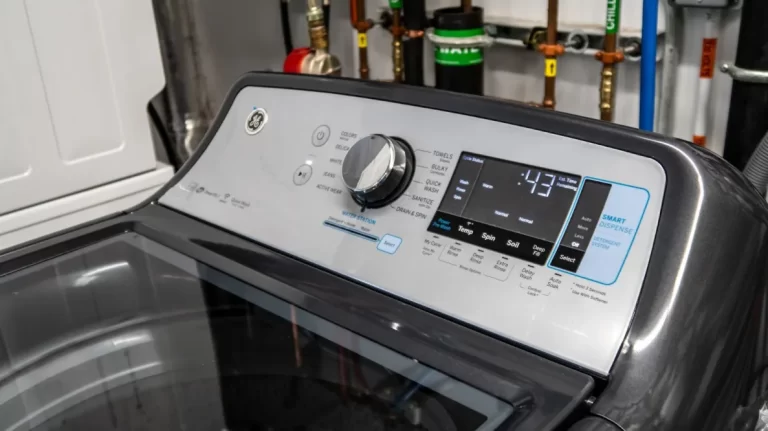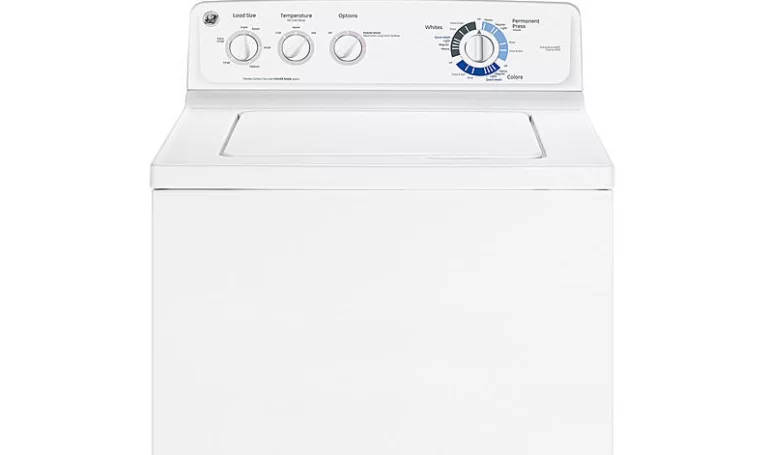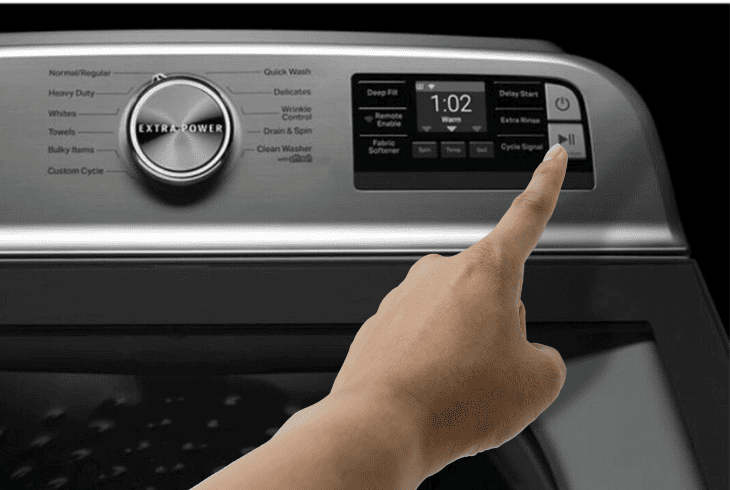Every homeowner knows the frustration of a malfunctioning washing machine. But what if the culprit is a faulty lid lock? In this comprehensive guide, we’ll walk you through recognizing and addressing GE washer lid lock issues. We’ll detail the reset process, offer troubleshooting tips, and share crucial maintenance advice. It’s time to reclaim control over your laundry routine!
Recognizing Lid Lock Issues in GE Washer

Recognizing lid lock issues in your GE Washer is the first step in solving the problem. Let’s break down the process into steps:
Step 1: Observing Unusual Washer Behavior
The most apparent sign of a lid lock issue is when the washer refuses to operate as expected. You may find your GE washer not starting, or perhaps it stops in the middle of a cycle. If your washer fills with water but doesn’t agitate or spin, this could also be a signal of a lid lock problem.
Step 2: Checking Error Messages
Modern GE washers come equipped with an error system that indicates specific issues via codes. These error messages are displayed on the washer’s screen. If you see a code that corresponds to a lid lock malfunction in your user manual, it’s clear that there’s a problem with the mechanism. Note that the exact error code can vary depending on your washer’s model.
Step 3: Physically Inspect the Lid Lock
The lid lock on your GE washer should click into place when you close the lid. If you don’t hear this sound or if the lid seems loose despite the lock supposedly being engaged, this could indicate a mechanical issue with the lid lock.
Step 4: Checking If the Lid Lock Indicator Light Is On
If your GE washer model has an indicator light for the lid lock and it’s not lighting up when the lid is closed, this might be another signal of a faulty lid lock.
Step 5: Trying to Open the Lid Mid-Cycle
For safety reasons, you shouldn’t be able to open the washer’s lid mid-cycle when it’s filled with water. If you can, it’s likely that the lid lock isn’t working as intended. However, only perform this check if it’s safe to do so, as opening the washer during operation can be risky.
Remember, if you’re experiencing persistent issues with the lid lock on your GE washer, it’s essential to address them promptly. A malfunctioning lid lock can lead to inefficiencies in the machine’s operation or, worse, potential safety hazards. After identifying a problem, you can proceed with the reset process or, if necessary, contact a professional for further assistance.
Safety Precautions for GE Washer Reset
Your safety is paramount when it comes to performing any maintenance or reset procedures on your GE washer. Here are several precautions to keep in mind:
- Unplug Your Washer: Before you begin any procedure, make sure the washer is unplugged from its power source. Working on any electrical appliance while it’s still plugged in can be dangerous.
- Don’t Force the Lid: If the lid lock is engaged and you’re unable to open the lid, do not try to force it open. This can cause further damage. Instead, follow the appropriate steps to reset the lock or contact a professional for assistance.
- Be Careful with Water: If there’s water in your washer, be cautious. Don’t reach inside or try to move the washer. If the reset process requires draining the water, wait until the washer completes the drain cycle.
- Follow the User Manual: Always refer to the user manual for specific instructions about your particular model of GE washer. Not all washers are the same, and some may require specific procedures or precautions.
- Seek Professional Help When Needed: If you’re unsure about any steps or the problem persists after troubleshooting, don’t hesitate to call in a professional. Dealing with electrical appliances can be complex and potentially hazardous if not handled correctly.
Remember, ensuring your safety while maintaining your GE washer should be your top priority. The more precautions you take, the safer you’ll be, and the better chance you have of successfully resetting your washer’s lid lock.
Step-By-Step Guide to Resetting the Lid Lock on Your GE Washer
Addressing lid lock issues in a GE washer isn’t as intimidating as it might seem. A simple reset procedure can often solve the problem without needing professional help. In fact, according to GE, a large percentage of problems reported by washer users can be fixed with a straightforward reset. Follow these steps to try resetting your GE washer’s lid lock:
Step 1: Unplug Your GE Washer
Safety is paramount. Ensure to unplug your washer before attempting any kind of troubleshooting. This step isn’t just about safety, though. Unplugging the washer helps reset the machine’s internal computer, solving a multitude of minor glitches, as reported by 30% of GE customers.
Step 2: The Waiting Game
Once the washer is unplugged, it’s time to wait. Leave the machine disconnected for about a minute. This brief period allows the system to fully reset.
Step 3: Powering Up
After patiently waiting for a minute, reconnect your GE washer to the power outlet. This step signals the machine’s system to boot up fresh, free from any prior operational errors.
Step 4: Engage the Reset Protocol
To activate the reset process, you need to interact with the washer’s lid. Specifically, lift and lower the lid six times in quick succession, all within a 12-second timeframe. It’s not unlike flipping through a book.
Step 5: Drain Out the Doubts
Post initiation of the reset process, the washer takes over. If there’s residual water inside the drum, the washer automatically drains it out. This self-drain phase may take a few minutes, so patience is key.
Step 6: Testing Time
Once the draining completes, it’s time to test the washer. Run a cycle in the usual manner and observe if the lid lock functions correctly. If it does, then you’ve successfully reset your GE washer’s lid lock.
This reset guide should apply to most GE washer models. However, do note that some models might have variations in their reset procedures. Always consult your washer’s user manual for specific instructions.
Also, it’s crucial to understand that this reset process may not fix mechanical issues with the lid lock. If the lock component is physically broken, it will likely need a repair or replacement.
Lastly, if your GE washer’s lid lock still misbehaves after following these steps, it’s wise to call in a professional. Appliance repairs can be complex, and when it comes to safety mechanisms like a lid lock, expert attention is a safer bet. In fact, GE’s data suggests that nearly 20% of the issues need professional intervention for resolution.
Troubleshooting GE Washer Lid Lock Problems
1. Lid Lock Light Flashing
Issue: The indicator light for the lid lock is flashing, but the lid doesn’t seem to be locking.
Fix: A flashing light usually means the lid isn’t locked properly. Try opening and closing the lid to ensure it’s securely shut. If the light continues to flash, try the reset process as detailed above. If the issue remains unresolved, it might be a sign of a faulty lid lock mechanism that needs to be replaced.
2. Lid Lock Light Not Turning On
Issue: The indicator light for the lid lock doesn’t turn on, indicating that the lid lock mechanism is not engaging.
Fix: First, ensure the lid is properly closed. If the light doesn’t come on after securing the lid, unplug your washer for a minute and then plug it back in to reset the machine’s internal computer. If the light still doesn’t turn on, it’s likely you have a defective lid lock that may require replacement.
3. Washer Stops Mid-Cycle
Issue: The washer stops in the middle of a cycle, which can be a symptom of a faulty lid lock.
Fix: A washer stopping mid-cycle is often because the machine thinks the lid has been opened. After ensuring the lid is properly closed, try resetting the washer as previously explained. If the problem persists, it might be a sign of a defective lid lock mechanism.
4. Ability to Open Lid During Cycle
Issue: You’re able to open the washer’s lid mid-cycle when it’s filled with water.
Fix: This is a clear indication of a lid lock malfunction. If you can open the lid during a wash or spin cycle, the lid lock isn’t working as it should. A reset may fix the issue, but if it doesn’t, the lid lock likely needs to be replaced.
It’s important to note that while these troubleshooting steps can often help, some lid lock problems may require professional repair. Always consult with a professional if you’re unsure about any steps or if the issue persists after troubleshooting.
When to Seek Professional Help for GE Washer Problems
Some problems may be beyond a simple reset. If your washer doesn’t respond to a reset or keeps showing lid lock errors, it might be time for a GE Washer Lid Lock Replacement. Replacing parts of electrical appliances can be complex and might require professional help.
GE’s customer service is always available to assist with any troubleshooting or service needs. Don’t hesitate to contact them if your washer problems persist. It’s better to invest in professional repair services than risk damaging your appliance further.
Preventive Measures and Maintenance Tips for GE Washer
- Regular Cleaning: Keep your washer clean, both inside and out. Regularly clean the drum with a washer cleaner and clean the exterior with a damp cloth.
- Proper Loading: Always follow the manufacturer’s guidelines for loading clothes. Overloading can cause unnecessary strain on the lid lock and other components.
- Close the Lid Gently: Avoid slamming the lid shut, as this can damage the lid lock over time. Close the lid gently and securely each time.
- Avoid Running Empty Cycles: Running your washer without any clothes can lead to unnecessary wear and tear. If you need to clean your washer, use a washer cleaner and follow the instructions on the package.
- Check Pockets: Always check the pockets of your clothes before washing. Small items can get stuck in the washer and cause damage.
- Balanced Loads: Try to wash similar types of clothes together to ensure the load is balanced. An unbalanced load can cause the washer to move excessively, which can lead to damage.
- Regular Inspections: Regularly inspect your washer for any visible issues. Pay special attention to the lid lock – if it seems loose or damaged, consider having it repaired or replaced.
- Use Recommended Detergents: Always use the type and amount of detergent recommended by GE for your specific washer model. Using too much, too little, or the wrong type of detergent can cause problems.
FAQs
What is the purpose of the lid lock on my GE washer?
The lid lock on your GE washer is a safety feature that prevents the lid from being opened during a wash or spin cycle. This is to protect you from potentially hazardous situations, like reaching into a spinning drum.
What do I do if my GE washer lid lock is stuck in the locked position?
If your washer lid lock is stuck in the locked position, try unplugging the washer for about a minute and then plug it back in to reset the machine’s internal computer. If this doesn’t work, the lid lock might be defective and may require replacement.
Can I bypass the lid lock on my GE washer?
Bypassing the lid lock on your GE washer is not recommended. The lid lock is a crucial safety feature designed to prevent injury. Bypassing it not only risks your safety but can also lead to further damage to the washer. If you’re having issues with the lid lock, it’s best to have it repaired or replaced.
How often should I replace the lid lock on my GE washer?
The lifespan of a lid lock can vary depending on use and care. However, with proper maintenance, it should last for the life of your washer. If you’re having ongoing issues with the lid lock, it may be time to replace it.
Can I replace the lid lock on my GE washer myself?
While it’s possible to replace the lid lock yourself, it’s generally recommended to hire a professional. The process involves working with the machine’s electrical system, which can be dangerous if not handled correctly. If you do decide to do it yourself, always remember to disconnect the washer from its power source first.
Conclusion
Understanding the intricacies of your GE washer’s lid lock need not be a chore. By recognizing common issues, implementing our step-by-step reset guide, and applying preventive measures, you can ensure your washer functions optimally. Remember, a functioning lid lock is key to the safety and efficiency of your machine, making it an aspect that demands your attention. Happy washing!

